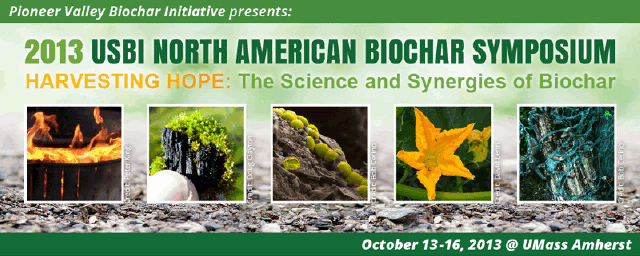Scale, Sales & Marketing
Scaling the Biochar Industry
Barry Hollister presentation
SSM Session 4 Hirst.pdf (5395 kB)
Peter Hirst presentation
Location
CC 162
Start Date
15-10-2013 10:00 AM
End Date
15-10-2013 11:20 AM
Session Description
Peter Hirst’s presentation looks into the fundamental forces and potential influences and tools at work in the scaling of a biochar industry. These forces and tools are found in the historic development of analogous industries: composting, natural gas production and distribution, electric power generation, residential home building, politics, and more. Through a decidedly Darwinian lens, it is seen that the inherent nature of biochar, dependent on local production and processing of low value feedstocks, would naturally evolve much in the way of the closely related compost industry, into relatively local, small-scale but widely distributed enterprises within identifiable carbon sheds. Other concepts explored will include memetic engineering, intelligent design, and efficiency threshold
Systems Thinking and Sizing the Biochar Industry
Biochar is a systems solution, addressing multiple problems at once. This presentation will start by giving a system’s context for biochar through describing systems thinking principles and disciplines like the Natural Step and Permaculture, two excellent tools for marketing biochar. This context will set the base for looking at the sustainable business trends that will predict the growth of the biochar industry. We will dive into four specific markets that will complement the growth of the biochar market - biofuels, waste-to-energy, biofertilizers, and remediation- and deliver market sizing projections for the biochar industry. Finally, we will review a couple stories of growth from other industries - the wind energy industry and organic dairy industry- to offer hope for how quickly the biochar industry can scale in the next five years.
Community Supported Agricultural and Energy financial models offer a realistic opportunity for local communities to deploy the science and synergies of Energy, Biochar and Agriculture to create the currencies that drive local economies while enhancing health, enriching wealth, securing local high nutrient food and renewable clean energy and contributing to the mitigation from adversities of climate disruption. Barry Hollister's presentation identifies barriers to growth and applicable solutions for hurtling these impediments to realize the potential for scaling the industry by embracing the promise of Biochar.
Scaling the Biochar Industry
CC 162
Peter Hirst’s presentation looks into the fundamental forces and potential influences and tools at work in the scaling of a biochar industry. These forces and tools are found in the historic development of analogous industries: composting, natural gas production and distribution, electric power generation, residential home building, politics, and more. Through a decidedly Darwinian lens, it is seen that the inherent nature of biochar, dependent on local production and processing of low value feedstocks, would naturally evolve much in the way of the closely related compost industry, into relatively local, small-scale but widely distributed enterprises within identifiable carbon sheds. Other concepts explored will include memetic engineering, intelligent design, and efficiency threshold
Systems Thinking and Sizing the Biochar Industry
Biochar is a systems solution, addressing multiple problems at once. This presentation will start by giving a system’s context for biochar through describing systems thinking principles and disciplines like the Natural Step and Permaculture, two excellent tools for marketing biochar. This context will set the base for looking at the sustainable business trends that will predict the growth of the biochar industry. We will dive into four specific markets that will complement the growth of the biochar market - biofuels, waste-to-energy, biofertilizers, and remediation- and deliver market sizing projections for the biochar industry. Finally, we will review a couple stories of growth from other industries - the wind energy industry and organic dairy industry- to offer hope for how quickly the biochar industry can scale in the next five years.
Community Supported Agricultural and Energy financial models offer a realistic opportunity for local communities to deploy the science and synergies of Energy, Biochar and Agriculture to create the currencies that drive local economies while enhancing health, enriching wealth, securing local high nutrient food and renewable clean energy and contributing to the mitigation from adversities of climate disruption. Barry Hollister's presentation identifies barriers to growth and applicable solutions for hurtling these impediments to realize the potential for scaling the industry by embracing the promise of Biochar.



Bio and Photo
Peter Hirst has been a natural resources and energy professional for 30 years, with 5 years of biochar management, production and training experience in his and Bob Wells’s company, New England Biochar, LLC. He works full time making and applying biochar, developing production equipment and practices, teaching and training in all phases of community scale biochar practice. Peter oversees the deployment and continued development of the original masonry Adam Retort for remote rural application. Recent installations are at Flow Farm, a research and teaching facility in North Carolina, Michigan Biochar, tierra Learning Center in Washington, and Universidad Magallanes in Puerto Natales, Chile. This last, in remote Southern Patagonia, is the southernmost biochar production facility on the planet. The newest unit, in Maui, Hawaii, is devoted entirely to making biochar from residues of organic, plantation-grown bamboo.
Amanda Joy Ravenhill is a professor of sustainable business at the Presidio Graduate School. She specializes in climate science and solutions with a focus on biochar. She is currently working on the book with Paul Hawken titled Drawdown, a comprehensive collection of climate solutions complete with business cases and full LCAs for each. Amanda is also a graphic facilitator, capturing meetings and presentations in visual form. Her passion for global issues comes from the intersection of two forces: being a TCK (Third Culture Kid: her parents were anthropologists in Africa, where she was born) and her muse: Buckminster Fuller.
Barry Hollister
Entrepreneur, visionary, futurist, advocate for sustainable energy, biochar, carbon negative agriculture and no carbon transportation systems. Biological Gardener and Small-Plot Farmer for over forty years. Founder, facilitator - Berkshire Harmony. Builder and facilitator of "proof of concept” actively operating financial models - CSA Home Delivery, Farmers Markets, Farm Stands and now moving forward with CHP Energy and Biochar Systems. Graduated San Francisco State College (University) BA in Government and the Harvard University’s Graduate School of Business Administration’s Owner President Management Program (HBS-OPM) specifically developed for well-established, seasoned, and authentic entrepreneurs. Studied with Joan Dye Gussow at Stone Barns Center for Food and Agriculture. Founder/CEO of Ski America Enterprises, now retired. Hollister advocates for understanding the entrepreneurial mind and adjusting the way one THINKSaccordingly, and lifestyle entrepreneurship with a focus on building a better, socially just, sustainable world that is better when we leave it than it was when stewardship responsibilities were entrusted to us.